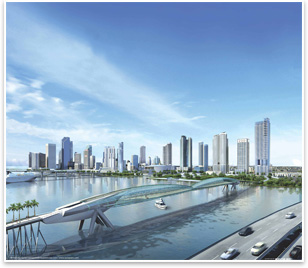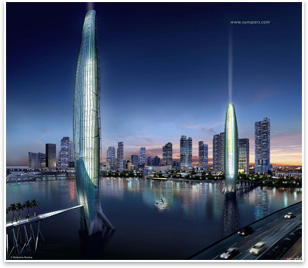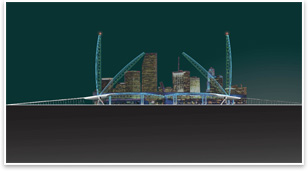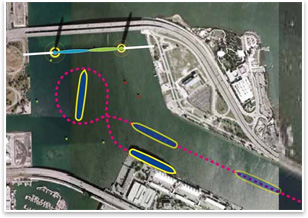|
Miami Bridge Draws Solar Power and Transforms into Two Vertical Observation Towers at Night
by Russell Boniface
Associate Editor
 Summary: Roberto Rovira, Assoc. AIA, principal of azimuth studio, inc., in Miami, took first place in the international Miami Monument Design Competition that called for visionary designs to distinguish the Miami skyline. Rovira’s “Miami Sunspars" pedestrian bridge design across Biscayne Bay proposes two horizontal pedestrian bridges that transform into two iconic solar-powered vertical observation towers at night, one on each end of the span. The Sunspars project would connect downtown Miami with a new island cultural epicenter. The competition, sponsored by the Miami-based architectural visualization company Spine3D and AIA Miami, drew close to 100 entries. Summary: Roberto Rovira, Assoc. AIA, principal of azimuth studio, inc., in Miami, took first place in the international Miami Monument Design Competition that called for visionary designs to distinguish the Miami skyline. Rovira’s “Miami Sunspars" pedestrian bridge design across Biscayne Bay proposes two horizontal pedestrian bridges that transform into two iconic solar-powered vertical observation towers at night, one on each end of the span. The Sunspars project would connect downtown Miami with a new island cultural epicenter. The competition, sponsored by the Miami-based architectural visualization company Spine3D and AIA Miami, drew close to 100 entries.
 The Miami Monument Design Competition sought entries for an iconic structure or monument that would highlight Miami and be distinctive along its skyline. Rovira’s "Miami Sunspars" original design configuration for the competition featured one pedestrian bridge that transformed into two vertical towers. The concept since has led to a revised configuration of two spans that derive their shape from a palm leaf, and feature adjoining walkways and column supports inspired by the root structure of a mangrove. The Miami Monument Design Competition sought entries for an iconic structure or monument that would highlight Miami and be distinctive along its skyline. Rovira’s "Miami Sunspars" original design configuration for the competition featured one pedestrian bridge that transformed into two vertical towers. The concept since has led to a revised configuration of two spans that derive their shape from a palm leaf, and feature adjoining walkways and column supports inspired by the root structure of a mangrove.
A Miami beacon
Rovira received a grant to develop the idea further. Although the competition had no limitations in terms of size, height, or budget, Rovira identified three locations to allow for reduced spans, so as to be within the realm of possibility. The primary location connects downtown Miami with what will become an island called Museum Park in Biscayne Bay, home to the Miami Art Museum and the Museum of Science & Planetarium combining with a new performing arts center completed last year by Cesar Pelli. On the east side of the bridge’s location would be the Miami Children's Museum, a natural habitat called Jungle Island, and a future high-end marina.
 “Currently, there are two sides of the Bay connected by an unfriendly causeway, with three lanes of high-speed traffic each way,” Rovira says. “There’s a sidewalk, but it’s not inviting. The idea is that the Miami Sunspars would create a vital pedestrian and bicycle connection and be a beacon with a monumental quality, noticeable from far away. It would have a dynamic quality, because during the day it would be an important pedestrian connection, and at night it would be illuminated, rotate vertically, and allow for people to go up into the towers by stairs or elevator. Presumably, there would be a skybox or observatory at the top. The underside of the bridge would have digital media with an uploadable digital banner that could announce the weather, events, and pictures of people—a register for Miami activity.” “Currently, there are two sides of the Bay connected by an unfriendly causeway, with three lanes of high-speed traffic each way,” Rovira says. “There’s a sidewalk, but it’s not inviting. The idea is that the Miami Sunspars would create a vital pedestrian and bicycle connection and be a beacon with a monumental quality, noticeable from far away. It would have a dynamic quality, because during the day it would be an important pedestrian connection, and at night it would be illuminated, rotate vertically, and allow for people to go up into the towers by stairs or elevator. Presumably, there would be a skybox or observatory at the top. The underside of the bridge would have digital media with an uploadable digital banner that could announce the weather, events, and pictures of people—a register for Miami activity.”
How it would work
Rovira’s pedestrian bridge design for each span has two symmetrical halves that meet in the middle and pivot at the supports to allow each half—or bridge—to rise independently. The support design calls for interwoven, root-like structures inspired by the form of a mangrove and allow for rising 500-foot-long walkways from land to each pivoting bridge half. The walkways would traverse 2,000 feet across the water and be shaded and planted.
 Rovira refers to the concept as a metronome. At sundown, the glass and steel towers come up and at sunrise they come down. “There will be interesting movement throughout the day,” he says. “The design is intended to operate as a balance counterweight. It is a bascule bridge, which has a heavy counterweight. On the bridge side is a longer structure, but ideally these two weights would balance it and require little energy to turn it from a horizontal to a vertical position.” The concept of the rising towers also allows for cruise ships to pass through. Rovira refers to the concept as a metronome. At sundown, the glass and steel towers come up and at sunrise they come down. “There will be interesting movement throughout the day,” he says. “The design is intended to operate as a balance counterweight. It is a bascule bridge, which has a heavy counterweight. On the bridge side is a longer structure, but ideally these two weights would balance it and require little energy to turn it from a horizontal to a vertical position.” The concept of the rising towers also allows for cruise ships to pass through.
On the surface of the towers would be “sunspars” covered with solar louvers to generate energy to operate the mechanics as well as digital displays and lighting. Explains Rovira: “It would be neutral in its energy consumption. When the bridge is down, it’s oriented east-west for maximum exposure, and at night as the towers go vertical they use the energy collected during the day. The concept began after hurricanes Katrina, Wilma, and Rita, which hit this area pretty hard. Miami was resilient and bounced back, because ultimately it has this energy. The shape for the Sunspars is this idea of a palm leaf that, through photosynthesis, can capture energy and release it.”
 Miami Sunspars would have visual appeal Miami Sunspars would have visual appeal
Rovira says that the Miami Sunspars pedestrian bridge design would appeal to water traffic in the Bay. “It would be at the very terminus of the cruise ship terminal, where we get all the cruise ships docking. They would essentially see the Sunspars. Having an appeal to the pedestrians was important, but also how it would look from the water would be significant as well.”
|



